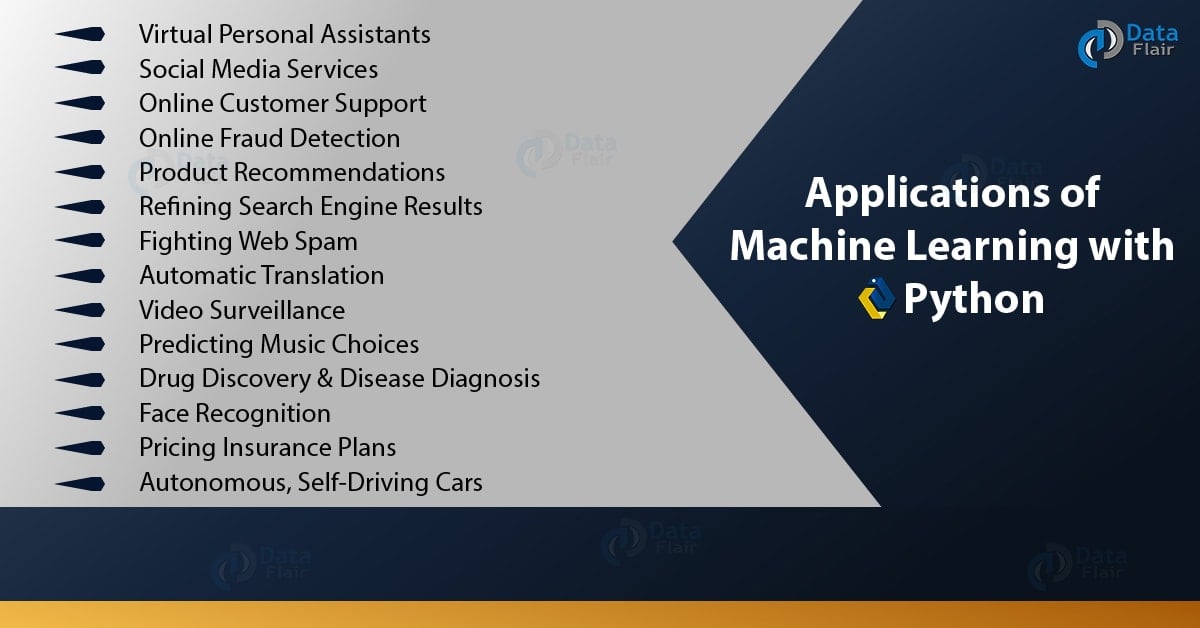17 Top Applications of Machine Learning with Python
Free Machine Learning courses with 130+ real-time projects Start Now!!
Python course with 57 real-time projects - Learn Python
1. Objective
In our last tutorial, we discuss Machine learning Techniques with Python. Today, we dedicate this Python Machine Learning tutorial to learn about the applications of Machine Learning with Python Programming. Let’s take a look at the areas where Machine is used in the industry.
So, start the Applications of Machine Learning with Python.
2. Why Python for Machine Learning Used?
Before we proceed to the applications of Machine Learning with Python, you’re probably asking yourself- why Python? Among tools like R programming and SAS, here’s why we’ll go with Python-
Follow this link to know about Machine Learning
a. Simple
The sole reason why Python is often chosen as an introductory language to programming is its simplicity. It is simple, yet powerful. Python is easy to write, and simple to understand. This behaviour of its makes it intuitive. Situations like getting your code from another developer that uses third-party components mean you need very little cognitive overhead. It is also true that code is read more often than it is written. Therefore, simplicity serves to be a great asset to Python.
b. Huge Set of Relevant Libraries
Python has a wide collection of libraries for machine learning purposes. These include Python NumPy, SciPy, scikit-learn, and many more. These are good with all intrinsic tasks of machine learning.
- scikit-learn- Good for data mining, data analysis, and machine learning.
- pylearn2- More flexible than scikit-learn.
- PyBrain- Modular ML library with flexible, easy, and powerful ML algorithms and predefined environments to test and compare algorithms.
- Orange- Open-source data visualization and analysis, has components for machine learning, has extensions for biometrics and text mining, has features for data analytics, supports data mining through visual programming or Python scripting.
- PyML- The Interactive object-oriented framework for machine learning, written in Python.
- Milk- Machine learning toolkit, has SVMs, k-NN, random forests, decision trees, performs feature selection.
- Shogun- Machine learning toolbox, focuses on large-scale kernel methods and SVMs.
- Tensorflow- High-level Neural Network Library.
Follow this link to know about Tensorflow Tutorial
3. Applications of Machine Learning with Python
a. Virtual Personal Assistants
Names like Siri and Alexa bring to mind the capabilities of virtual assistants. We can ask Siri to make a call for you or play music. You can request Alexa for today’s weather forecast. You can even set an alarm or send an SMS. What makes this easier on you is that you only need to speak to it and it will listen to your command. This comes in handy for those differently abled. Such assistants take note of how you interact with them and use that to make your next experience with them better.
b. Social Media Services
By now, you would have noticed several features of Facebook- ‘People You May Know’ and ‘Face Recognition’. It uses machine learning to monitor your activity- what profiles you visit, which people to send requests to, which ones you accept requests of, the people you tag, among much more. With this, Facebook hopes to provide you with a richer experience on its platform so you will use it regularly.
Do you know the Reasons Why Should we Learn Python
c. Online Customer Support
Websites like educators and shopping platforms will often pop a live chat up to help you with your questions. A visitor with a head full of questions is more likely to leave than stay and possibly make a purchase. Some websites use a chatbot instead to pull information to the website and try to address the customer’s queries.
d. Online Fraud Detection
If you’re familiar with PayPal, you realize your trust with it. It uses machine learning to stand in defence against illegal acts like money laundering. By comparing millions of transactions, it can find out which ones are illegitimate.
e. Product Recommendations
Shopping platforms like Amazon and Jabong notice what products you look at and suggest similar products to you. If this gets a favourite product across to you and results in a purchase you make with them, it’s a win for them. For this, it also uses your wishlist and cart contents.
Read about Python Functions with Syntax and Examples
f. Refining Search Engine Results
The searches you make in search engines like Google monitor your response. Do you visit a top listing and stick around for a while? Do you get to the third page and leave without clicking any link? Google makes note of the findings and aims to improve your search next time.
g. Fighting Web Spam
Many email clients use rule-based spam filtering. Spammers develop new tricks to get around this. So, clients like Gmail use machine learning to keep their spam filters updated. This is also a problem with Google search results and other search engines. Common spam-filtering techniques are Multi-Layer Perceptron and C 4.5 Decision Tree Induction.
h. Automatic Translation
Machine Learning lets us translate text into another language. The ML algorithm for this figures how words fit together and then uses this information to improve the quality of a translation. With this, we can also translate the text on images using neural networks to identify letters.
Let’s Explore Python PyQt5 Tutorial
i. Video Surveillance
Some crimes can be avoided by sensing them way before they can happen. Behaviour, like standing motionless, napping on a bench, and following another individual, can alert human attendants via a video surveillance system.
j. Predicting Music Choices
Products like Genius by Apple Music monitors what you listen to. Later, it can suggest you a list of songs you are likely to prefer. It also picks songs from your playlist to create libraries that sound good together.
k. Drug Discovery and Disease Diagnosis
With ML algorithms, we can perform the following tasks-
- Initial screening of drug compounds.
- Predicting success rate based on biological factors.
- R&D technologies like Next-Generation Sequencing.
- Understand disease processes.
- Design effective treatments for diseases.
- Personalizing drug combinations.
- Produce cheaper drugs with improved replication.
- Research and develop diagnostics and therapeutic treatments.
Read about Python Statistics – p-Value, Correlation, T-test, KS Test
l. Face Recognition
Facilities like face detection are often something we see with Facebook. When we want to tag a photo, Facebook automatically suggests us a few names. Most of the times, the first name is accurate for the face it has detected. This has machine learning to credit.
m. Pricing Insurance Plans
Machine Learning can detect if a driver is likely to cause a large-loss case during the term of insurance. This lets insurance firms price insurance plans accordingly.
n. Autonomous, Self-Driving Cars
These cars receive data on nearby objects and their sizes and speeds via sensors. Based on how they behave, it categorizes objects as cyclists, pedestrians, and other cars among others. It uses this data to compare stored maps to current conditions. Such cars make use of Machine Vision algorithms.
Do you know the Python Data Science Environment Setup
4. More Machine Learning Applications
Other than what we just mentioned, we can use Machine Learning for the following purposes-
- Identifying human genes that predispose people to cancer.
- Identifying what consumers respond to.
- Trading stocks and derivatives.
- Packet inspection for anti-virus software.
- Delayed aeroplane flights.
- Factory maintenance diagnostics.
- Behavioural advertisement for products.
So, this was all about Applications of Machine Learning with Python. Hope you like our explanation.
5. Conclusion
Hence, we conclude our tutorial on applications of machine learning with Python. Got more to add? Feel free to drop it in the comments below.
Related Topic-
Machine Learning Techniques
For reference
Did we exceed your expectations?
If Yes, share your valuable feedback on Google

















NICE BLOGS POSTS